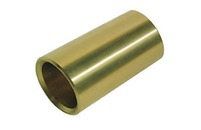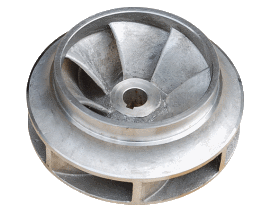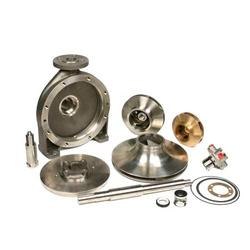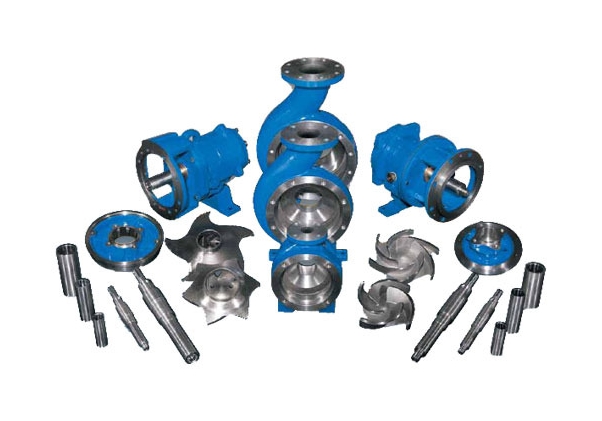Pump Shaft Sleeves
A shaft sleeve is a cylindrical hollow metal tube placed over the shaft to protect as it passes through the packing. Pump shafts are often protected from erosion, corrosion, and wear at leakage joints, seal chambers, internal bearings and in the waterways by renewable sleeves. The most common shaft sleeve function is that of protecting the shaft from packing wear at the stuffing box. A shaft sleeve used between two multistage pump impellers in conjunction with the inter-stage bushing to form an inter-stage leakage joint is called an inter-stage or distance sleeve.
These are used in single stage pumps. Impeller and sealing gland are not directly mounted on shaft. A sleeve is fitted between the bore of the impeller and OD of the shaft and keyed with the shaft i.e. impeller rotate with the sleeve along with the shaft. The wearable part in this type of assembly is the sleeve, which is far less expensive than the shaft. The function of the impeller sleeves is to protect the shaft from wear and coming in contact with the pumping fluid.
Pump shafts are usually protected from erosion, corrosion, and wear at seal chambers, leakage joints, internal bearings, and in the waterways by renewable sleeves. The most common shaft sleeve function is that of protecting the shaft from wear at packing and mechanical seals. Shaft sleeves serving other functions are given specific names to indicate their purpose. For example, a shaft sleeve used between two multistage pump impellers in conjunction with the interstage bushing to form an interstage leakage joint is called an interstage.
In medium-size centrifugal pumps with two external bearings on opposite sides of the casing (the common double-suction and multistage varieties), the favoured shaft sleeve construction uses an external shaft nut to hold the sleeve in an axial position against the impeller hub.Sleeve rotation is prevented by a key, usually an extension of the impeller key. The axial thrust of the impeller is transmitted through the sleeve to the external shaft nut.In larger high-head pumps, a high axial load on the sleeve is possible and a design similar to that shown in Figure 1 may be preferred. This design has the advantages of simplicity and ease of assembly and maintenance. It also provides space for a large seal chamber and cartridge-type mechanical seals. When shaft sleeve nuts are used to retain the sleeves and impellers axially, they are usually manufactured with right- and left-hand threads. The friction of the pumpage and inadvertent contact with stationary parts or bushings will tend to tighten the nuts against the sleeve and impeller hub (rather than loosen them). Usually, the shaft sleeves utilize extended impeller keys to prevent rotation.
Some manufacturers favour the sleeve, in which the impeller end of the sleeve is threaded and screwed to a matching thread on the shaft. A key cannot be used with this type of sleeve, and right- and left-hand threads are substituted so that the frictional grip of the packing on the sleeve will tighten it against the impeller hub. As a safety precaution, the external shaft nuts and the sleeve itself use set screws for a locking device. In pumps with overhung impellers, various types of sleeves are used. Most pumps use mechanical seals, and the shaft sleeve is usually a part of the mechanical seal package supplied by the seal manufacturer.
Many mechanical seals are of the cartridge design, which is set and may be bench-tested for leakage prior to installation in the pump.
For overhung impeller pumps that utilize packing for sealing, the packing sleeves generally extend from the impeller hub through the seal chambers (or stuffing boxes) to protect the pump shaft from wear. If a hook-type sleeve is used, the hook part of the sleeve is clamped between the impeller and a shaft shoulder to maintain the axial position of the sleeve.
A hook-type sleeve used to be popular for overhung impeller pumps that operate at high temperatures because it is clamped at the impeller end and the rest of the sleeve is free to expand axially with temperature changes. But with the increased use of cartridge-type mechanical seals, the use of hooktype sleeves is diminishing.
In designs with a metal-to-metal joint between the sleeve and the impeller hub or shaft nut, a sealing device is required between the sleeve and the shaft to prevent leakage. Pumped liquid can leak into the clearance between the shaft and the sleeve when operating under a positive suction head and air can leak into the pump when operating under a negative suction head. This seal can be accomplished by means of an O-ring, or a flat gasket. For high temperature services, the sealing device must be either acceptable for the temperature to which it will be exposed, or it must be located outside the high temperature liquid environment. According to an alternative design used for some high-temperature process pumps, the contact surface of the hook-type sleeve and the shaft is ground at a 45-degree angle to form a metal-to-metal seal. That end of the sleeve is locked, but the other is free to expand with temperature changes. When O-rings are used, any sealing surfaces must be properly finished to ensure a positive seal is achieved.
All bores and changes in diameter over which O-rings must be passed should be properly radiused and chamfered to protect against damage during assembly. Guidelines for assembly dimensions and surface finish criteria are always listed in O-ring manufacturers’ catalogs.
At Global Pumps & Spares, we keep a full range of shaft sleeves in ready stock.
Shaft Sleeves are available for Kirloskar Pumps, KSB Pumps, Beacon Pumps, Mather Platt (Wilo) Pumps, etc
Shaft Sleeve M.O.C. – EN8, EN19, C.I, S.S 410, S.S 304, S.S 316, Bronze etc.
Manufactured from best quality raw materials, the Pump Shaft Sleeves are available in different grades and sizes as per the needs of our esteemed customers.
More details at http://www.globalpumps.in/shaft-sleeves.html
Ref: share.pdfonline. com/28e0ed0290b f4decb032241d4b333b67/ PROJECT FINAL.pdf



